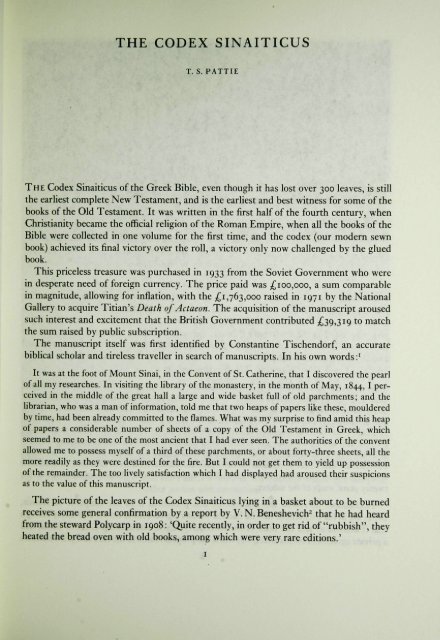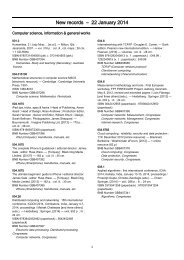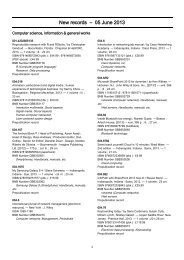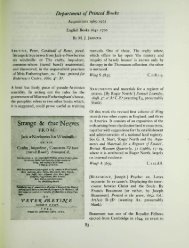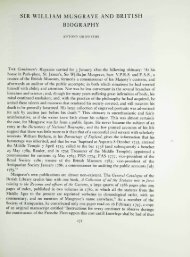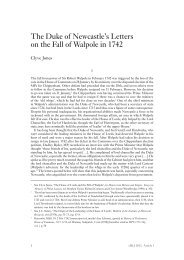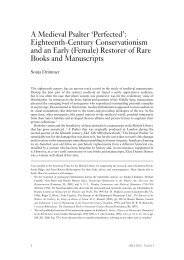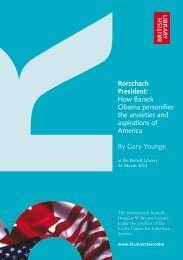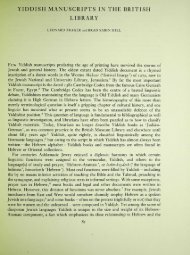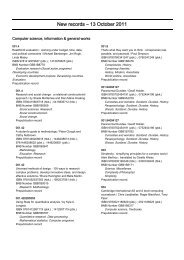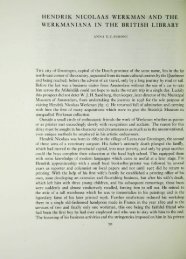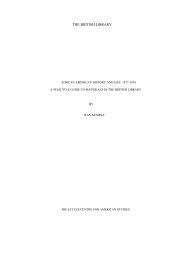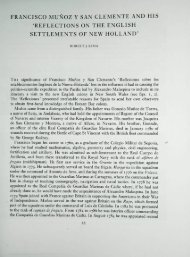THE CODEX SINAITICUS - British Library
THE CODEX SINAITICUS - British Library
THE CODEX SINAITICUS - British Library
You also want an ePaper? Increase the reach of your titles
YUMPU automatically turns print PDFs into web optimized ePapers that Google loves.
<strong>THE</strong> <strong>CODEX</strong> <strong>SINAITICUS</strong><br />
T. S. PATTIE<br />
<strong>THE</strong> Codex Sinaiticus of the Greek Bible, even though it has lost over 300 leaves, is still<br />
the earliest complete New Testament, and is the earliest and best witness for some of the<br />
books of the Old Testament. It was written in the first half of the fourth century, when<br />
Christianity became the official religion of the Roman Empire, when all the books of the<br />
Bible were collected in one volume for the first time, and the codex (our modern sewn<br />
book) achieved its final victory over the roll, a victory only now challenged by the glued<br />
book.<br />
This priceless treasure was purchased in 1933 from the Soviet Government who were<br />
in desperate need of foreign currency. The price paid was ;£ioo,ooo, a sum comparable<br />
in magnitude, allowing for infiation, with the j£ 1,763,000 raised in 1971 by the National<br />
Gallery to acquire Titian's Death ofActaeon. The acquisition of the manuscript aroused<br />
such interest and excitement that the <strong>British</strong> Government contributed £39,319 to match<br />
the sum raised by public subscription.<br />
The manuscript itself was first identified by Constantine Tischendorf, an accurate<br />
biblical scholar and tireless traveller in search of manuscripts. In his own words :^<br />
It was at the foot of Mount Sinai, in the Convent of St. Catherine, that I discovered the pearl<br />
of all my researches. In visiting the library of the monastery, in the month of May, 1844, I Perceived<br />
in the middle of the great hall a large and wide basket full of old parchments; and the<br />
librarian, who was a man of information, told me that two heaps of papers like these, mouldered<br />
by time, had been already committed to the flames. What was my surprise to find amid this heap<br />
of papers a considerable number of sheets of a copy of the Old Testament in Greek, which<br />
seemed to me to be one of the most ancient that I had ever seen. The authorities of the convent<br />
allowed me to possess myself of a third of these parchments, or about forty-three sheets, all the<br />
more readily as they were destined for the fire. But I could not get them to yield up possession<br />
of the remainder. The too lively satisfaction which I had displayed had aroused their suspicions<br />
as to the value of this manuscript.<br />
The picture of the leaves of the Codex Sinaiticus lying in a basket about to be burned<br />
receives some general confirmation by a report by V. N. Beneshevich^ that he had heard<br />
from the steward Polycarp in 1908: 'Quite recently, in order to get rid of "rubbish", they<br />
heated the bread oven with old books, among which were very rare editions.'
Fig. I. Codex Sinaiticus. Double opening: end of Gospel of Luke and beginning of Gospel of<br />
John. Each page written in four columns<br />
Tischendorf took back to Frederick Augustus II of Saxony, who had sponsored his<br />
journey, the manuscripts he had collected including the 43 leaves from Sinai which he<br />
called the Codex Friderico-Augustanus in honour of his patron. All these manuscripts<br />
were deposited in the University <strong>Library</strong>, Leipzig, where they still are. He visited the<br />
monastery for the third time on 31 January 1859. On 4 February the steward entertained<br />
him in his cell and, resuming a former conversation, said •? 'And I too have read a SeptUagint'<br />
(i.e. Greek Old Testament). He then brought out a<br />
bulky kind of volume, wrapped up in a red cloth and laid it before me. I unrolled the cover, and<br />
discovered, to my great surprise not only those very fragments which, fifteen years before, I had<br />
taken out of the basket, but also other parts of the Old Testament, the New Testament complete,<br />
and in addition the Epistle of Barnabas and a part of the Pastor of Hermas. Full of joy, which<br />
this time I had the self-command to conceal from the steward and the rest of the community,<br />
I asked, as if in a careless way, for permission to take the manuscript into my sleeping chamber<br />
to look over it more at leisure. There by myself I could give way to the transport of joy which<br />
I felt. I knew that I held in my hand the most precious Biblical treasure in existence - a document<br />
whose age and importance exceeded that of all the manuscripts which I had ever examined during<br />
twenty years' study of the subject.<br />
Tischendorf borrowed the manuscript and presented it to the Emperor of Russia,<br />
believing in his excitement that he had the monks' agreement to do so. It is likely enough<br />
that Tischendorf and the head of the monastery, Cyril, Archbishop-Elect of Sinai, had<br />
a private agreement to this effect, but when the proposal came to the ears of Cyril's enemies
itxr roexe b ceo YKX<br />
nxcxtrixcHMC<br />
KX|-roKXTD| Kei N Mc^<br />
XHM<br />
2. Codex Sinaiticus. Page from the Psalms written in two columns. Psalm 23 ('KB') and<br />
other psalms with corrections<br />
^
he was forced in self-defence to say that there was no intention of giving away the manuscript.<br />
This impossible situation was regularized by the Russian diplomatic service ten<br />
years later, in 1869, by an agreement with the new Archbishop of Sinai, Callistus, in<br />
which the monks agreed to donate the manuscript to the Emperor, and the Emperor gave<br />
the monks some money and some decorations. However, the monks on Sinai still resent<br />
the way in which their Treasure was given away.<br />
Once the manuscript was in St. Petersburg Tischendorf gave it the name of Codex<br />
Sinaiticus Petropolitanus, in honour of its place of discovery and its place of residence.<br />
He prepared a luxurious edition complete with scholarly commentary, in 'facsimile type'<br />
of the 346^ leaves, published in 1862 at Russian expense. The 43 leaves at Leipzig he had<br />
already published. Both parts were pubhshed in 1911 in collotype facsimile by Kirsopp<br />
and Helen Lake.<br />
The text of our Bible is supremely well attested, but there are a few puzzles. One of<br />
these is the ending of the Gospel of Mark, which has two main forms, the long ending<br />
and the short ending. The Sinaiticus agrees with other early manuscripts like the Vaticanus<br />
in having the short ending. Another puzzle is the story of the adulterous woman (John 7:<br />
53-8: 11) which some manuscripts place after John 7: 36, or 7: 52, or 21: 24, or even after<br />
Luke 21: 38. The Sinaiticus, like the Vaticanus, omits the adulterous woman altogether.<br />
Are we to assume that there was at an early date an editorial decision to leave out both of<br />
these sections, this decision being reflected in the Sinaiticus and Vaticanus, but not<br />
in the text which became standard in the Orthodox Church and thence in the Authorized<br />
Version ? It seems quite likely. There is no separate translation of the Codex Sinaiticus,<br />
but many of its readings, including the two we have just discussed, are recorded in the<br />
New English Bible, and in 1869 Tischendorf published in Leipzig an edition of the English<br />
Authorized Version, with the variant readings in English of the Sinaiticus, Vaticanus,<br />
and Alexandrinus as the thousandth volume in the Tauchnitz collection of <strong>British</strong> authors.<br />
But what is the point, the poor taxpayer may ask, of paying out so much money for an<br />
old book, which has already been carefully studied by that conscientious scholar Tischendorf<br />
and which, moreover, has been published in facsimile by Professor and Mrs. Lake?<br />
The answer to that is to be found in a superb book called The Scribes and Correctors of<br />
the Codex Sinaiticus^ by H.J.M.Milne and T.C. Skeat. Milne and Skeat were able to<br />
show decisively that only three scribes and not four were responsible for the manuscript<br />
(Tischendorf had called the anonymous scribes A, B, C, and D: the work attributed to<br />
C should in reality be attributed to A and D). These three scribes, who were all carefully<br />
trained to write in the same style, can be distinguished not so much by the letter forms,<br />
but by the general appearance of the page, some habits of punctuation, and above all the<br />
decorative tail-piece with which the scribe ended each book of the Bible. The tail-piece<br />
amounts to the scribe's signature and Milne and Skeat were able to show that the tailpiece<br />
could be used to distinguish scribes in the other two early Greek Bibles, Codex<br />
Vaticanus and Codex Alexandrinus.<br />
After the scribes of the Codex Sinaiticus had been securely identified, an interesting<br />
feature emerged - they were not equally good at spelling. Greek spelling is like English
in that both became fixed at a certain period, but the pronunciation changed in succeeding<br />
centuries. Consequently Greek speakers of the period after Christ, like English speakers<br />
of today, had to learn correct spelling by memory. Of the three scribes, D was an excellent<br />
speller, A a poor speller, and B an appaUingly bad speller. It is an entertaining thought<br />
that the human frailty of the weakest of these spellers is enough to demolish a theory<br />
formulated sixteen hundred years later. The traditional view was that commercial copies<br />
of books were made by a group of scribes listening to a reader. Kurt Ohly,^ however,<br />
denied that dictation was used, and pointed to the marks indicating the number of lines<br />
nrr<br />
CXT<br />
kxi rfA^^xc TXT<br />
KAIO/AAMeNOTi<br />
AXHencecrnNH<br />
r I<br />
KXI<br />
HTXl<br />
A'XYTOMOl M XITON<br />
KOCM OWX-CDfHCT<br />
TX rp A4>O M fc N XK »<br />
KAIXt »<br />
Fig. 3. Codex Sinaiticus. End of St. John's Gospel with earlier colophon<br />
drawn in pencil from traces visible by ultra-violet light<br />
u
written (stichomctry) and to the consideration that a certain number of scribes copying<br />
and recopying by eye would produce the same amount of work as if dictation were used,<br />
and of course far more accurately. Ohly's theory is exploded by the evidence of spelling -<br />
the miserable B omits letters or syllables or duplicates syllables or adds meaningless letters<br />
in a way that would be incredible if he were copying by eye. Besides, 4 Maccabees and<br />
Psalms are both begun by D and continued by A, and the spelling reflects the change of<br />
hand. From another point of view B's spelling is valuable evidence of the current pronunciation,<br />
such as the confusion between ot and f, and omission of intervocalic y {ouv<br />
for (j)vy€Lv^ Act for Aeyct, and conversely Xeyovrocs for AeoKras"). It is worth making the poin<br />
that the excellence of D's spelling is paralleled by other scribes who could spell.<br />
Under ultra-violet light it was possible to read letters that had been erased and written<br />
over. One surprising discovery was that originally the Gospel of John ended at 21: 24. The<br />
tail-piece and end-title were later deleted, verse 25 was added with a fresh tail-piece and<br />
end-title (fig. 3). It seemed that an unknown editor decided on internal grounds that the<br />
Gospel ended at 21:24, and that verse 25 was an interpolation, which has been argued in<br />
modern times.<br />
Another surprise seen under ultra-violet light, was at Matthew 6: 28: 'Consider how the<br />
lilies grow in the fields; they do not work, they do not spin/ This is the reading of the<br />
New English Bible which also adds at the foot of the page: 'One witness reads "Consider<br />
the lilies: they neither card nor spin nor labour".' This is the original reading of the Codex<br />
Sinaiticus, subsequently corrected to the familiar version. The original reading seems<br />
a great improvement on the familiar reading: it makes a perfect parallel with the birds of<br />
the air in verse 26: 'they do not sow and reap and store in barns.' It is so much better<br />
that it outweighs, in my opinion, the evidence of the other 5,000 manuscripts of the Greek<br />
New Testament.<br />
1 C. Tischendorf, Codex Sinaiticus. The Ancient<br />
Biblical Manuscript nom in the <strong>British</strong> Museum.,<br />
Tischendorf's slory and Argument related by<br />
Himself. 8th edn., [1934], p. 23.<br />
2 V. N. Beneshevich, Opisante grecheskikh rukopisei<br />
monastyrya Sv. Ekateriny, I [1911], p- xvi, n. i.<br />
6<br />
3 C. Tischendorf, op. cit., p. 27.<br />
4 K.Ohly, Sttchometrische Untersuchungen (Zentralblatt<br />
fiir Bihliothekswesen, Beiheft 61), 1928,<br />
PP- 123-5.


